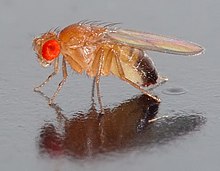| Sophophora | |
|---|---|
 | |
| A male Drosophila melanogaster fly | |
| Scientific classification | |
| Domain: | Eukaryota |
| Kingdom: | Animalia |
| Phylum: | Arthropoda |
| Class: | Insecta |
| Order: | Diptera |
| Family: | Drosophilidae |
| Subfamily: | Drosophilinae |
| Genus: | Drosophila |
| Subgenus: | Sophophora Sturtevant, 1939 |
| Type species | |
| Drosophila melanogaster Meigen, 1830 | |
| Species groups | |

The paraphyletic subgenus Sophophora of the genus Drosophila was first described by Alfred Sturtevant in 1939. [1] It contains the best-known drosophilid species, Drosophila melanogaster . Sophophora translates as carrier ( phora ) of wisdom ( sophos ). The subgenus is paraphyletic because the genus Lordiphosa [2] [3] and the species Hirtodrosophila duncani [4] [5] are also placed within this subgenus.